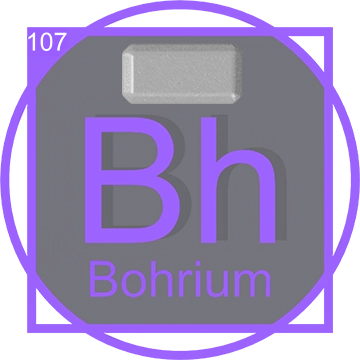Bohrium (Bh): The Synthetic Marvel of the Periodic Table
Introduction to Bohrium
Bohrium, with the symbol Bh and atomic number 107, is a synthetic, highly radioactive element that stands out in the periodic table due to its intriguing properties and complex production process. This element is part of the transactinide series and the seventh member of the 6d series of transition metals.
Discovery of Bohrium

Bohrium was first synthesized in 1981 by a team of scientists at the Gesellschaft für Schwerionenforschung (GSI) in Darmstadt, Germany. The discovery team, led by Peter Armbruster and Gottfried Münzenberg, achieved the creation of Bohrium by bombarding Bismuth-209 with Chromium-54 ions. This marked a significant milestone in the field of nuclear chemistry, contributing to our understanding of superheavy elements.
Role in the Periodic Table and Scientific Research

As a superheavy element, Bohrium occupies a unique position in the periodic table. It is part of the group known as the transactinides, elements known for their extreme instability and radioactivity. The study of Bohrium and similar elements helps scientists explore the limits of the periodic table and the stability of nuclei, offering insights into both nuclear physics and chemistry. For more detailed information, visit our comprehensive periodic table.
Physical and Chemical Properties
Due to its short half-life and intense radioactivity, the physical and chemical properties of Bohrium have not been extensively characterized. Predictive studies suggest that Bohrium would exhibit properties similar to its lighter homologues, such as Rhenium and Technetium, including high melting points and metallic characteristics.
Applications and Future Research

Currently, the applications of Bohrium are confined to scientific research, particularly in the fields of nuclear physics and chemistry. Future research aims to synthesize more stable isotopes of Bohrium, which could potentially uncover new chemical properties and reactions that are not possible with naturally occurring elements.
Conclusion
Bohrium’s synthesis and study represent the pinnacle of modern scientific achievement in the field of element discovery. The ongoing research into Bohrium and other synthetic elements continues to challenge and expand our understanding of the material world.
Synthesis of Bohrium
Bohrium is not found naturally on Earth and is instead synthesized in a laboratory setting. The element is produced by bombarding lighter nuclei with charged particles in a particle accelerator. Specifically, Bohrium was first synthesized by bombarding bismuth-209 with chromium-54 ions at high speeds. This process, known as the cold fusion reaction, led to the creation of Bohrium-262, an isotope with a very short half-life.
Due to the complexity and costs associated with its production, Bohrium has only been produced in minute amounts, and there are no mining sites for Bohrium as it does not naturally occur in the Earth's crust.
Modern Uses and Research
Currently, Bohrium has no practical applications outside of scientific research due to its extremely short half-life and the challenges associated with producing it. The primary use of Bohrium today is in nuclear research where scientists study its properties to gain insights into the structure and properties of superheavy elements.
Future Prospects of Bohrium

The future research on Bohrium is poised to focus on the synthesis of more stable isotopes that might exist in the so-called 'island of stability,' a theoretical region in the periodic table where superheavy elements could have longer half-lives. Discovering more stable isotopes could potentially unlock new chemical properties and applications, possibly in materials science or nuclear medicine. Additionally, research into Bohrium and similar elements can help refine our understanding of nuclear reactions and atomic theory.












